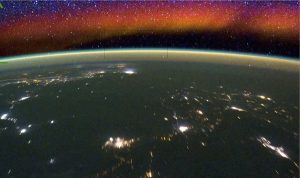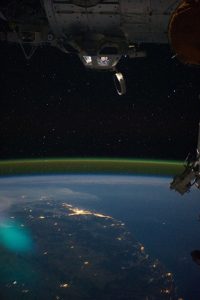21 June 2017
WASHINGTON, DC — Dating back to the first century, scientists, philosophers and reporters have noted the occasional occurrence of “bright nights,” when an unexplained glow in the night sky lets observers see distant mountains, read a newspaper or check their watch.
A new study accepted for publication in Geophysical Research Letters, a journal of the American Geophysical Union, uses satellite data to present a possible explanation for these puzzling historical phenomena.
The authors suggest that when waves in the upper atmosphere converge over specific locations on Earth, it amplifies naturally occurring airglow, a faint light in the night sky that often appears green due to the activities of atoms of oxygen in the high atmosphere. Normally, people don’t notice airglow, but on bright nights it can become visible to the naked eye, producing the unexplained glow detailed in historical observations.
Few, if any, people observe bright nights anymore due to widespread light pollution, but the new findings show that they can be detected by scientists and may still be noticeable in remote areas. Bright airglow can be a concern for astronomers, who must contend with the extra light while making observations with telescopes.
“Bright nights do exist, and they’re part of the variability of airglow that can be observed with satellite instruments,” said Gordon Shepherd, an aeronomer at York University in Toronto, Canada, and lead author of the new study.
A historical mystery

The different layers of Earth’s airglow can be seen from the International Space Station as it orbits Earth. The very thin green layer above the bottom of the window occurs 95 kilometers (59 miles) above Earth’s surface; the red region above is a different type of airglow. The rectangle represents the portion of the airglow measured in a single WINDII image.
Historical accounts of bright nights go back centuries. Pliny the Elder described bright nights, saying, “The phenomenon commonly called ‘nocturnal sun’, i.e. a light emanating from the sky during the night, has been seen during the consulate of C. Caecilius and Cn. Papirius (~ 113 BCE), and many other times, giving an appearance of day during the night.”
European newspapers and the scientific literature also carried observations of these events in 1783, 1908 and 1916.
“The historical record is so coherent, going back over centuries, the descriptions are very similar,” Shepherd said.
Modern observations of bright nights from Earth are practically nonexistent. Even devoted airglow researchers like Shepherd and his colleagues have never seen a true bright night with their eyes. But even before the advent of artificial lighting, bright nights were rare and highly localized.
“Bright nights have disappeared,” Shepherd said. “Nobody sees them, nobody talks about them or records them any longer, but they’re still an interesting phenomenon.”
Airglow anomalies

Earth’s airglow can be seen from the International Space Station as a greenish bubble 95 kilometers (59 miles) above the Earth’s surface.
Credit: NASA
Shepherd knew of the historical observations and could see bright night events reflected in airglow data from the Wind Imaging Interferometer (WINDII), an instrument once carried by NASA’s Upper Atmosphere Research Satellite (1991-2005), but he couldn’t explain why the phenomena occurred.
He and his co-author, Youngmin Cho, a research associate at York University, searched for mechanisms that would cause airglow to increase to visible levels at specific locations.
Airglow comes from emissions of different colors of light from chemical reactions in the upper reaches of the atmosphere. The green portion of airglow occurs when light from the sun splits apart molecular oxygen into individual oxygen atoms. When the atoms recombine, they give off the excess energy as photons in the green part of the visible light spectrum, giving the sky a greenish tinge.
To find factors that would cause peaks in airglow and create bright nights, the researchers searched two years of WINDII data for unusual airglow profiles, ruling out meteors and aurora, which have their own distinct signatures. They identified 11 events where WINDII detected a spike in airglow levels that would be visible to the human eye, two of which they describe in detail in the study.
Finally, the researchers matched up the events with the ups and downs of zonal waves, large waves in the upper atmosphere that circle the globe and are impacted by weather. When the peaks of certain waves aligned, they produced bright night events that could last for several nights at a specific location. These events were four to 10 times brighter than normal airglow and could be responsible for the bright nights observed throughout history.
“This [study] is a very clear, new approach to the old enigma of what makes some night skies so remarkably bright, and the answer is atmospheric dynamics,” said Jürgen Scheer, an aeronomer at Instituto de Astronomía y Física del Espacio in Buenos Aires, who was not connected to the study. “We now have a good idea which dynamical phenomena are behind [airglow] events of extreme brightness.”
Observing a bright night
From their data, the researchers estimate that at a specific location, visible bright nights occur only once per year, and their observation would rely on a sky watcher looking from a remote location on a clear, moonless night with dark-adjusted eyes. Shepherd estimates that a bright night occurs somewhere on Earth, at different longitudes, on about 7 percent of nights.
If an astronomer wanted to experience a bright night personally, Shepherd suspects that scientists could predict their occurrence if they monitored the waves continuously, so that they could calculate when their peaks would align.
The next challenge will be to reproduce the observed convergence of these waves through modeling and to consider the effects of other types of waves in the atmosphere, Scheer said.
“Maybe it’s an almost dead question,” Shepherd said. “I’m having the last word before it dies.”
###
The American Geophysical Union is dedicated to advancing the Earth and space sciences for the benefit of humanity through its scholarly publications, conferences, and outreach programs. AGU is a not-for-profit, professional, scientific organization representing 60,000 members in 137 countries. Join the conversation on Facebook, Twitter, YouTube, and our other social media channels.
Notes for Journalists
This research article is open access for 30 days. A PDF copy of the article can be downloaded at the following link: http://onlinelibrary.wiley.com/doi/10.1002/2017GL074014/pdf.
Journalists and PIOs may also order a copy of the final paper by emailing a request to Lauren Lipuma at [email protected]. Please provide your name, the name of your publication, and your phone number.
Neither the paper nor this press release is under embargo.
“WINDII airglow observations of wave superposition and the possible association with historical ‘bright nights’”
Authors:
Gordon G. Shepherd: Centre for Research in Earth and Space Science, York University, Toronto, Canada;
Youngmin Cho: Centre for Research in Earth and Space Science, York University, Toronto, Canada.
Contact information for the authors:
Gordon Shepherd: [email protected], +1 (416) 736-2100 Ext: 33221
Lauren Lipuma
+1 (202) 777-7396
[email protected]